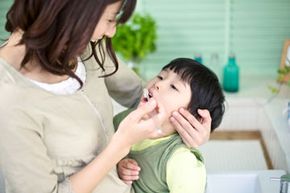Plaque is unpleasant. It's pasty, it smells bad and it's harmful -- especially to kids.
Plaque is an ugly, yellowish film of tiny food particles and bacteria which tends to accumulate in crevices but can grow anywhere, even on the front of teeth [sources: Hoffman; Teach Kids How]. If it's dealt with quickly, it can easily be removed, but as time goes on plaque becomes tartar: a hardened substance that, if not scraped off by a dentist, can lead to cavities or even a disease of the gums known as gingivitis [source: Hoffman].
Advertisement
The reason it's particularly bad for kids is because of the makeup of their teeth. Baby teeth have a thinner protective layer of enamel so plaque can do its dirty work even faster [source: SoftDental]. While it's true that those teeth will eventually be replaced by permanent teeth, plaque-infested baby teeth can cause little ones a lot of discomfort. Once the enamel is eroded, the nerve of the tooth is exposed and irritated.
Plaque is unsightly, smelly, unhealthy and potentially a source of pain. So, what can you do about it? Quite a lot, actually. With a little instruction and creative coaxing (think parental help and the right tools) along with periodic assistance from a friendly dentist, plaque can be nothing more than an unwelcome visitor who is regularly shown the door. It all begins, of course, with the parents -- parents who show a determination to make plaque removal a part of the youngster's daily routine. Some of it may sound obvious while other approaches can seem overly time-consuming or extreme, but all of it works.
Advertisement

